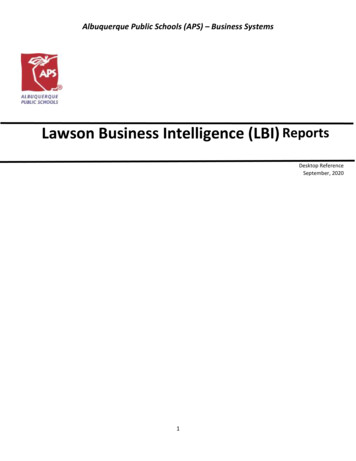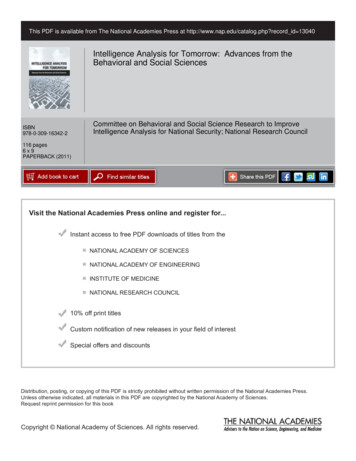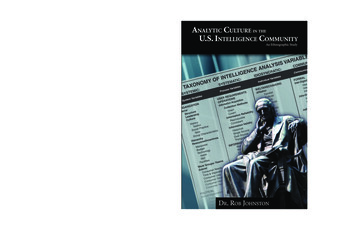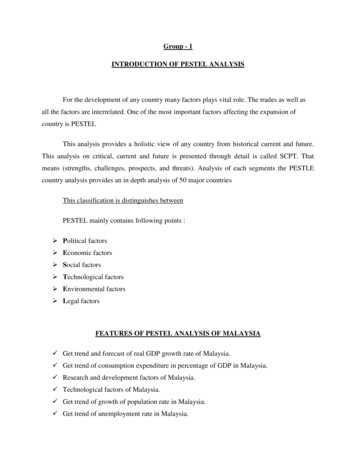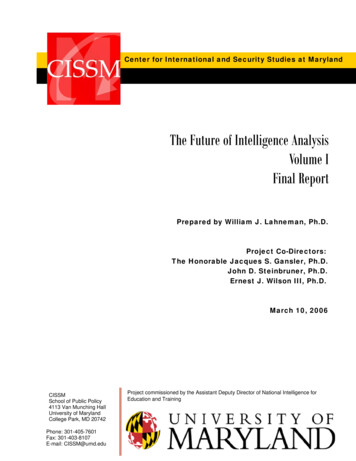
Transcription
Center for International and Security Studies at MarylandThe Future of Intelligence AnalysisVolume IFinal ReportPrepared by William J. Lahneman, Ph.D.Project Co-Directors:The Honorable Jacques S. Gansler, Ph.D.John D. Steinbruner, Ph.D.Ernest J. Wilson III, Ph.D.March 10, 2006CISSMSchool of Public Policy4113 Van Munching HallUniversity of MarylandCollege Park, MD 20742Phone: 301-405-7601Fax: 301-403-8107E-mail: CISSM@umd.eduProject commissioned by the Assistant Deputy Director of National Intelligence forEducation and Trainingi
AcknowledgementsThe project directors wish to express their thanks to Richard Danzig, John Gannon,Christopher Kojm, John McLaughlin, and Mike McConnell for reviewing andcommenting on the preliminary draft of this report.Many thanks to all of the nongovernment experts from academia and the business sectorwho participated in project workshops:Gordon Adams – George Washington UniversityRamon C. Barquin – Barquin International, Inc.Richard K. Betts – Columbia UniversityJames G. Breckenridge – Mercyhurst CollegeDuncan Clarke – American UniversityDale Copeland – University of VirginiaG. Edward DeSeve – University of MarylandJay C. Farrar – Center for Strategic and International StudiesAnn A. Fishman – Generational Targeted Marketing CorporationJames Holden-Rhodes – New Mexico State University, Las CrucesMartin C. Libicki – RANDKenneth T. Stringer – Booz Allen Hamilton Inc.Phil Williams – University of PittsburghThanks also to Bridget Grimes, Kevin Jones, Andrea White, Anja Kuznetsova, ShirleyHsieh, and Scott Morrissey for their work as rapporteurs and facilitators for the project.Most of all, thank you to the many members of the intelligence community who madethis report meaningful by actively participating in the project’s events.The views contained in this report are those of the project directors and staff alone. Thepersons thanked above are not responsible for its content and should not be blamed forany defects that are present. The views expressed in this report do not represent theviews, attitudes or policies of any agency or component of the U.S. government.i
Executive SummaryThis study contains the findings and recommendations of the Future of IntelligenceAnalysis Project, an eighteen-month effort that explored what must be done to providethe US government with an effective intelligence analysis capability in the future.Unlike most current studies, which analyzed a small number of recent intelligencefailures, the project was forward-looking. It used the year 2020 as a notional date ofreference because individuals currently entering the analytic workforce will be theseasoned analysts of 2020. The project focused on intelligence analysis and organizedits research around the themes of analyst education, recruitment, training,management, organization, and retention. A series of four workshops and a capstoneconference engaged analysts and managers from throughout the intelligence communityin dialogue with nongovernment experts. Members of the following agencies andorganizations participated: the Office of the Director of National Intelligence; the CentralIntelligence Agency; the Defense Intelligence Agency; the National Security Agency; theNational Geospatial Intelligence Agency; the Office of Naval Intelligence; ArmyIntelligence; the National Ground Intelligence Center; the Joint Military IntelligenceCollege; the Sherman Kent School for Intelligence Analysis; the Foreign BroadcastInformation Service; the National Air and Space Intelligence Center; HeadquartersMarine Corps; Marine Corps Intelligence Activity; the National Maritime IntelligenceCenter; the Department of Homeland Security; the Federal Bureau of Investigation; andthe U.S. Coast Guard.A panel of distinguished experts critiqued a preliminary draft of the report. This panelconsisted of the Honorable Richard Danzig, former Secretary of the Navy; John C.Gannon, former Chairman of the National Intelligence Council and former Staff Directorof the House Select Committee on Homeland Security; Christopher Kojm, President ofthe 9/11 Discourse Project and former Deputy Director of the 9/11 Commission; John M.(Mike) McConnell, Vice Admiral, U.S. Navy (ret.), former Director of the NationalSecurity Agency; and the Honorable John E. McLaughlin, former Acting Director ofCentral Intelligence. Their comments have been integrated into this report, and areincluded in detail in Appendices B through F.The report concluded that, if current practices continue, the intelligence community(IC) of 2020 will experience an imbalance between the demand for effective overallintelligence analysis and the outputs of the individually-oriented elements andoutlooks of its various analytic communities. The world and the threats within it arebecoming increasingly diffused in nature – with non-military threats increasing inrelation to purely military ones – while the intelligence community is producing analyststailored to perform specific, focused missions within an analytic enterprise thatemphasizes secrecy and segregation of effort over knowledge sharing and unity of effort.The next few years are critical because the present time offers a rare opportunityfor implementing significant changes to improve the effectiveness of the intelligenceenterprise. The shock of 9/11 has forced leaders and the current IC workforce to lookii
critically at current approaches. The pressing need to hire large numbers of entry-levelanalysts complements these factors by providing a receptive analytic workforce. But thiswindow of opportunity is already closing.Overall, this report calls for an “integrated culture” across the intelligencecommunity in order to provide the nation with the analytic outputs that the comingenvironment will require. The project’s findings fall into four broad categories: thosedealing with IC culture; those pertaining to analyst leadership, management, andcareer dynamics; those concerning education and training; and those dealing withimplementation strategies.With regard to IC culture, the report calls for establishing the basis for the professionof intelligence analyst across the IC. The U.S. intelligence community is a series ofnearly autonomous organizations, each with its own way of doing business. The analyticportion of the IC reflects the fragmentation of the overall intelligence enterprise. Such afragmented approach is at odds with the need for greater knowledge sharing to enableeffective analysis of dispersed threats and other issues. To establish the basis for theprofession of intelligence analyst across the IC, the report recommends the developmentof mission statements for all members of the intelligence enterprise; common doctrineand standardized job descriptions for analytic positions; creation of standards forprofessional ethics; an institutionalized capability for analyzing both failures andsuccesses and implementing best practices; increasing collaboration by crafting an ICwide doctrine for knowledge sharing; and mandating rotational assignments for analyststhroughout the IC.Second, the IC must expand analysts’ abilities to consult with non-governmentexperts. The increasing importance of open source intelligence means that IC analystsmust share certain information and knowledge with experts in academia, business, andresearch centers around the world. This need will increase significantly by 2020. The ICshould provide analysts with extended external training and education, includingsabbaticals. Rotational assignments should include opportunities for analysts to leave theIC and return without penalty. The IC should encourage peer review of analytic productsby outside experts; expand outsourcing activities; reduce constraints preventingcontractors from working at the same level as government employees; and developmechanisms to encourage the outside world to link with analysts.Third, the IC must develop IC-wide security, classification, and technologicalsystems. Physical and information security and clearance systems vary across the IC andare incompatible with many important partners at the state and local levels ofgovernment. These factors, along with lack of common information technology (IT)standards, impede knowledge sharing. Security clearance policies also adversely affectanalyst recruitment. The IC should develop overarching security, classification, and ITstandards for the entire IC. These systems should support the analytic enterprise andmust be responsive to changing conditions. Current conditions severely impede thedevelopment of a common IC culture, and knowledge sharing – both among IC agenciesand with outside experts – cannot thrive as long as security, classification and IT systemsiii
restrict it. The IC should create common standards for information technology,standardized security and classification systems, and an IC-wide information repository.The approval system for experimenting with new information technologies should bestreamlined.With regard to analyst leadership, management, and career dynamics, the report’sfourth finding calls for creating compatible human resource policies across the IC.There is a need for common standards for recruitment, hiring, retention, certification,training and promotion across the IC. The IC’s number one priority should be having toppeople. Clear standards are essential ingredients in achieving this goal. The IC shouldimplement standardized, collaborative IC-wide recruiting policies; emphasize “ICbranding” over individual agency branding in the analyst recruitment process; institute acommon IC-wide personnel system with regulations detailing how to promote andcompensate analysts and managers; integrate “best practices” in IC hiring and promotionacross all IC agencies; generate standardized HR data, including baseline data onintellectual capital across the IC; establish standards for firing; hire adequate numbers ofanalysts to support career development, training and rotation; develop policies to allowanalysts who have left the IC to return without penalty; and develop a program to identifyin advance and utilize on demand non-government experts and former IC analysts.Fifth, the IC needs to draft a common IC-wide career development program. Clearcareer paths motivate analysts to remain engaged as members of the IC. Insofar aspossible, these should be common career paths that are valid throughout the IC so thatanalysts and managers know what is expected of them. The IC is now hiring newanalysts with different expectations than the current workforce and the IC will bechallenged to give them jobs that meet these expectations. The report recommends thatthe IC provide multiple, standardized career paths with clear requirements and standards,including clear incentives to move into different career paths depending on the IC’sneeds, and clear milestones that analysts and managers must accomplish to move to thenext level. Additionally, the IC should create mentoring programs and expand the use ofinternship programs across the IC, and should encourage transfers and rotations inside theIC. It should make the accomplishment of rotational tours a requirement for analysts andmanagers to be promoted.Sixth, the IC needs to improve analyst leadership and management. Effectiveleadership and management are critical to ensuring an effective analytic enterprise.Managers are largely responsible for the quality of analytic products. They alsodecisively affect the retention of analysts by their leadership style and influence onorganizational culture. Ideally, managers are agents of change in their organizations. Ata minimum, they should not suppress other, informal agents of change. The IC shouldimprove and formalize educational and training programs for its managers, includingcontinuing training at all levels. It also should reward managers through appropriateincentive systems. Specifically, the IC should change how performance is measured toreflect quality of analysis over quantity of analytic product.iv
With regard to education and training, the report’s seventh finding identifies acrucial need to develop education and training programs that not only improveanalysis directly but also professionalize the analytic workforce. Education andtraining are low priority activities throughout the IC. The fact that managers do notreceive consistent training throughout their careers probably reinforces this bias.Essentially the IC is stressing questionable short-term gains over the long-term benefitsof a better-educated analytic workforce. The report’s recommendations include using theNational Intelligence University System to coordinate all education and trainingprograms across the IC, including agency-specific programs and programs offered byuniversities; making as many education and training programs as possible IC-wideinitiatives; initiating a mandatory, joint “boot camp” for all analysts in the IC within thefirst 6 months of employment; developing a coordinated education and trainingcontinuum for managers as well as analysts so that education and training becomes astandard, periodic feature of analysts’ and managers’ careers; making theaccomplishment of mandatory educational and training milestones a requirement foranalysts and managers to be promoted; instituting continuing education requirementsacross the analytic community; and sizing the analyst workforce to allow an appropriatepercentage of analysts to engage in education and training without causing the rest of theworkforce to be chronically shorthandedWith respect to implementation strategies, the report’s eighth finding deals with theneed to develop and aggressively pursue implementation strategies. Members of thereport’s review panel stressed that the project’s findings and recommendations were ontarget and emphasized the importance of moving forward. However, they noted thatsome of the report’s recommendations had been identified in previous studies but had notbeen implemented. They cautioned to expect strong resistance to the report’srecommendations in many parts of the IC. This fact made it critically important todevise appropriate implementation strategies and detailed action plans. Theyrecommended that a mechanism be developed to maintain continuing pressure for changeand observed that use of an outside organization serving as honest broker had distinctadvantages over depending on the IC to monitor its own progress toward implementation.They recommended several areas where additional work would be beneficial.Last but not least, the report’s ninth finding addressed whether additional legislationwould be necessary to bring about needed changes. The project concluded thatadditional legislation was not required as a means to compel needed changes.Rather, existing legislation already provides the Director of National Intelligence with thenecessary authority. Strong leadership by the DNI, with the explicit approval and supportof the President, would not only be sufficient to bring about needed change but alsowould result in better overall results.v
Table of ContentsAcknowledgementsExecutive SummaryTable of ContentsiiiviTHE FUTURE OF INTELLIGENCE ANALYSISIntroduction1The Problem2Window of Opportunity5Project Design6Findings and Recommendations9APPENDICESAppendix A. Competencies of Successful Intelligence AnalystsA-1Appendix B. Comments on the Preliminary Report byThe Honorable Richard DanzigB-1Appendix C. Comments on the Preliminary Report by John GannonC-1Appendix D. Comments on the Preliminary Report by Christopher KojmD-1Appendix E. Comments on the Preliminary Report byJ. M. (Mike) McConnellE-1Appendix F. Summary of Oral Presentation byThe Honorable John E. McLaughlinF-1Appendix G. Biographical Sketches of Project Participants(Nongovernment)G-1Appendix H. Summary of Findings and RecommendationsH-1vi
THE FUTURE OF INTELLIGENCE ANALYSISIntroductionThis study contains the findings and recommendations of the Future of IntelligenceAnalysis Project, an eighteen-month effort that explored what must be done to providethe US government with an effective intelligence analysis capability in the future. Theyear 2020 was the notional date of reference because it is near enough to makereasonably accurate forecasts possible but still far enough away to be influenced bypolicies enacted in the next few years. And the next few years are critical. Individualsentering the analytic workforce in the next several years will be the seasoned analysts of2020. They will only be effective if they are properly educated recruited, trained,managed, organized – and retained, in one way or another – as assets of the U.S.intelligence community (IC).In general, the study concludes that the Intelligence Reform and Terrorism PreventionAct of 2004 is a necessary step – but not a sufficient one – to improve the IC’s ability todetect and warn about new threats to the United States. Mark Lowenthal, former DeputyDirector of Central Intelligence for Analysis and Production, summed up the situationaptly when he said, “The intelligence community currently is confronted byinsurmountable opportunities.” His clever turn of phrase captured the difficulty inherentin attempting to alter the form of a group of disparate organizations – the U.S.intelligence community – through top-down measures alone even when most agree thatchange is necessary. While the Intelligence Reform Act embodies many appropriateinitiatives, these will fail unless intelligence agencies change the ways they do their dayto-day business and, to some degree, come to resemble one another much more than iscurrently the case.The report concludes that additional legislation is not required as a means to compelneeded changes, asserting instead that existing legislation already provides the Directorof National Intelligence (DNI) with the necessary authority. Strong leadership by theDNI, with the explicit approval and support of the President, would not only be sufficientto bring about needed change but also would result in better overall results. However, itnotes that many elements of the Goldwater-Nicols Defense Reorganization Act of 1986,which initiated sweeping reforms of the U.S. military by restructuring personnelincentive systems and organizational relationships, can serve as a valuable guide fordeveloping implementation strategies for the report’s recommendations.1
The ProblemIf current practices continue, the intelligence community (IC) of 2020 willexperience an imbalance between the demand for effective overall intelligenceanalysis and the outputs of the individually-oriented elements and outlooks of itsvarious analytic communities. The world and the threats within it are becomingincreasingly diffused in nature – with non-military threats increasing in relation to purelymilitary ones – while the intelligence community is producing analysts tailored toperform specific, focused missions within an analytic enterprise that emphasizes secrecyand segregation of effort over knowledge sharing and unity of effort. This developmenthas three main components. First, the nature of many threats is changing. Second,policymakers’ expectations are changing. Third, short-term intelligence is emphasizedover mid- and long-term analysis.Since the end of the Cold War, the intelligence community has contended with theemergence of new threats to national security from a number of quarters, includingincreasingly powerful nonstate actors such as transnational terrorist groups. Many ofthese actors have capitalized on the still evolving effects of globalization to threaten U.S.security in nontraditional ways. At the same time, global trends such as the populationexplosion, uneven economic growth, urbanization, the AIDS pandemic, developments inbiotechnology, and ecological trends such as the increasing scarcity of fresh water inseveral already volatile areas are generating new drivers of international instability.These trends make it extremely challenging to develop a clear set of priorities forcollection and analysis.1Intelligence analysts are tasked with making sense of these developments, identifyingpotential threats to U.S. national security, and crafting appropriate intelligence productsfor policy makers. They also will continue to perform traditional missions such asuncovering secrets that potential adversaries desire to withhold and assessing foreignmilitary capabilities. This means that, besides using traditional sources of classifiedinformation, often from sensitive sources, they must also extract potentially criticalknowledge from vast quantities of available open source information. Significantly, thecommunity must devise ways to monitor open source information in transformed ways.Additionally, some kinds of information currently not considered open source must bebrought into the open domain.For example, the process of globalization, empowered by the Information Revolution,will require a change of scale in the IC’s analytical focus. In the past, the IC focused on asmall number of discrete issues that possessed the potential to cause severe destruction ofknown forms. The future will involve security threats of much smaller scale. These willbe less isolated, less the actions of military forces, and more diverse in type and morewidely dispersed throughout global society than in the past. Their aggregate effects1For an appreciation of the uncertainty surrounding how the world of 2020 might develop, see thealternative future scenarios in Mapping the Global Future: Report of the National Intelligence Council’s2020 Project Based on consultations With Nongovernment Experts Around the World (GovernmentPrinting Office, December 2004). Available at http://www.cia.gov/nic/NIC globaltrend2020.html.2
might produce extremely destabilizing and destructive results, but these outcomes willnot be obvious based on each event alone. Therefore, analysts increasingly must look todiscern the emergent behavioral aspects of a series of events.Second, phenomena of global scope will increase as a result of aggregate humanactivities. Accordingly, analysts will need to understand global dynamics as neverbefore. Information is going to be critical, as well as analytical understanding of the newinformation, in order to understand these new dynamics. The business of organizing andcollecting information is going to have to be much more distributed than in the past, bothamong various US agencies as well as international communities. Information andknowledge sharing will be essential to successful analysis, and most of the necessarysharing will need to be conducted on a voluntary basis.Third, future analysts will need to focus on anticipation and prevention of security threatsand less on reaction after they have arisen. For example, one feature of the medicalcommunity is that it is highly reactive. However, anyone who deals with infectiousdiseases knows that prevention is the more important reality. Preventing infectiousdiseases must become the primary focus if pandemics are to be prevented. Futureanalysts will need to incorporate this same emphasis on prevention to the analyticenterprise.It appears evident that in this emerging security environment the traditional methods ofthe intelligence community will be increasingly inadequate and increasingly in conflictwith those methods that do offer meaningful protection. Remote observation,electromagnetic intercept and illegal penetration were sufficient to establish the order ofbattle for traditional forms of warfare and to assure a reasonable standard that any attemptto undertake a massive surprise attack would be detected. There is no serious prospectthat the problems of civil conflict and embedded terrorism, of global ecology and ofbiotechnology can be adequately addressed by the same methods.To be effective in the future, the IC needs to remain a hierarchical structure in order toperform many necessary functions, but it must be able to generate collaborative networksfor various lengths of time to provide intelligence on issues demanding interdisciplinaryanalysis. These networks should integrate OSINT and should contain experts from theprivate sector as well as the IC. The IC also should seek ways to include the knowledgeof former IC analysts in these networks.Clearly, the magnitude of this challenge means that analysts in one intelligence agencywill need to share information with analysts in other parts of the intelligence community– and with outside organizations – to produce accurate intelligence about complex issues.However, achieving successful collaboration is difficult because this goal clashes withthe secretive organizational cultures of the various U.S. intelligence agencies. As aresult, the intelligence community has been criticized for “stovepiping” – failing to shareinformation when appropriate—and is now wrestling with this difficult problem.3
The proliferation of potential threats and the Information Revolution also have changedpolicy makers’ expectations about intelligence products. Policy makers not only aredemanding that the intelligence community provide new kinds of information about newthings from new sources delivered in new ways, but also have tapped into sources ofopen information that compete with the products the intelligence community provides.Policy makers and their staffs are using these open sources as substitute sources ofintelligence. As a result, today’s intelligence analyst works in an environment that ismore competitive than it has ever been, and competition is likely to intensify even furtherin the future. To remain effective, the IC must compete with new sources of intelligenceas a unitary actor, bringing all of its strengths to bear. It will lose influence if IC agenciescontinue to compete destructively among themselves for the attention of policymakers byhoarding information.Currently, the pressing requirements of short-term intelligence collection, analysis,production and distribution draw attention away from important longer-term issues. Thishas called into question the sustainability of the analytic enterprise itself because, asnoted above, many emerging threats involve core issues of national security. Thesedemand long-term approaches to have a chance of achieving the necessary degree ofprevention.4
Window of OpportunityThe present time offers a rare opportunity for implementing significant changes toimprove the effectiveness of the intelligence enterprise. The shock of 9/11 has forcedleaders and the current IC workforce to look critically at current approaches. The clearand present need to hire large numbers of entry-level analysts complements these factorsby providing a receptive analytic workforce that will support change if initiatives areconstructive, guided by effective leadership, and sensitive to the generational shift andmovement toward a more culturally diverse workforce that is occurring within the IC.This window of opportunity is temporary. Project participants cautioned that change forchange’s sake was a distinct possibility, and that even well-thought out initiatives wouldfail in the absence of strong leadership, since, like most bureaucracies, the current ICembodies a strong ability to resist change.History shows that there is cause for optimism. Other organizations have gone throughradical transformations and emerged vastly improved. For example, the GoldwaterNichols Act successfully addressed a huge problem that plagued the U.S. armed forces:the demonstrated inability of the military services to work effectively together as a jointteam in conducting military operations.There is no reason that the IC cannot succeed as well. Significantly, it is not the onlygroup that must deal with these considerations. Public institutions, businesses,universities and non-profit organizations also face similar uncertainty in this time of rapidchange. They all need to analyze their present situations, determine their goals, andproduce effective implementation and management plans under these circumstances.Like the intelligence community, these organizations must both share certain kinds ofinformation with other organizations while keeping other types of information secret.5
Project DesignSince the study is forward looking, it does not directly address the strengths orshortcomings of the many analytic works examining the 9/11 attacks, the failure to findweapons of mass destruction in Iraq, the prosecution of the War on Terrorism, and recentactions to initiate reform of the U.S. intelligence enterprise. Naturally theseconsiderations were in the minds of project participants, but as benchmarks of currentpractice rather than the source of specific recommendations for change.Rather, project participants identified trends in the international environment that mightaffect U.S. interests and deduced the kinds of skills that future analysts would need topossess. Participants then analyzed how developments in technology could enable theanalytic enterprise. In some cases, the need to incorporate new technologies to assistanalysts in identifying and understanding new threats led participants to develop neworganizational structures for analysts, plus new ways of managing and leading them.Project recommendations stemmed from comparing these findings to current practices,including those embodied in the Intelligence Reform and Terrorism Prevention Act of2004.Initially, the project intended to examine the analytic enterprise by focusing on analystrecruitment, retention, and professional education and training, since all of theseprocesses must mesh properly within a single integrated process to produce an effectiveanalytic enterprise. Those recruited must have the appropriate skill sets, professionaleducation must provide the right background, training must hone skills, and the retentioneffort must retain sufficient numbers of optimally trained, experienced, and motivated,analys
Mar 10, 2006 · School of Public Policy 4113 Van Munching Hall University of Maryland College Park, MD 20742 . Intelligence; the National Ground Intelligence Center; the Joint Military Intelligence College; the Sherman Kent School for Intelligence Analysis; the Foreign Broadcast . intelligence analysis

